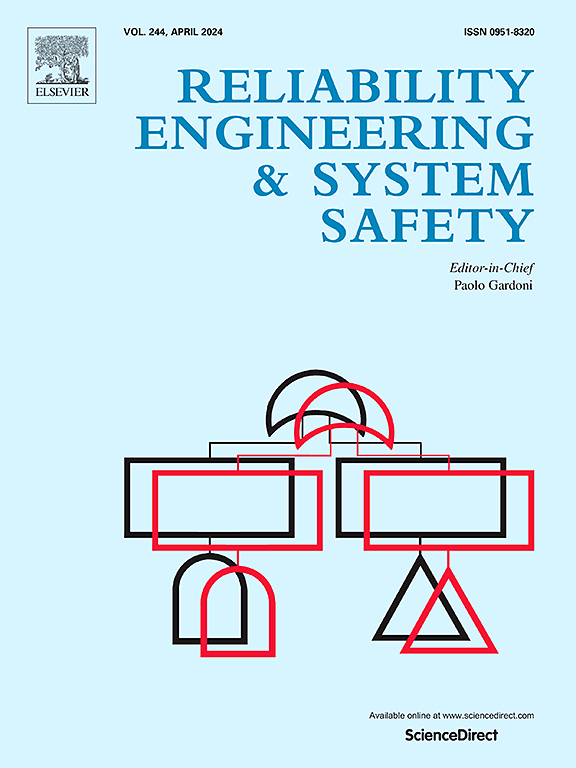Strengthening and protecting hubs against sequential unintentional and intentional disruptions considering decision-dependent uncertainty
IF 11
1区 工程技术
Q1 ENGINEERING, INDUSTRIAL
引用次数: 0
Abstract
This paper studies the strengthening and protection of multiple allocation hub networks subject to sequential unintentional and intentional disruptions, with the unintentional impacts occurring first, followed by the intentional impacts. We develop a two-stage stochastic bi-level programming model that incorporates decision-dependent uncertainty, where the first stage focuses on strengthening against unintentional impacts, and the second stage addresses protection against intentional impacts. The first stage determines the optimal strengthening strategy, incorporating various types to address multiple unintentional impacts, each with varying levels of intensity. The imperfect effect of strengthening and unintentional impacts makes decision-dependent uncertainty in the hub’s post-disruption operation state, which probabilistically depends on the strengthening decision and the intensity level of unintentional disruptions, and is interpreted using the contest success function. The second stage corresponds to a scenario-based bi-level hub interdiction median problem with fortification, formulated as a Stackelberg game between the defender and the attacker. To solve the proposed model, we develop a novel hybrid algorithm based on its structure, which utilizes the benefits of genetic algorithms, simulated annealing, and a greedy heuristic separation approach. We also develop a maximum-likelihood sampling method as a core component of the proposed hybrid algorithm to enhance its performance. Experimental results demonstrate the effectiveness of our proposed model and hybrid algorithm. The results also analyze the impact of the discount factor and strengthening budget on the expected network cost. Additionally, the results highlight the advantage of our model in incorporating multi-level disruption intensity, decision-dependent uncertainty, and sequential disruptions.
考虑到依赖决策的不确定性,加强和保护枢纽免受连续的无意和有意破坏
本文研究了多配置枢纽网络在先后发生无意干扰和有意干扰的情况下,先发生无意干扰后发生有意干扰的强化与保护问题。我们开发了一个包含决策依赖不确定性的两阶段随机双级规划模型,其中第一阶段侧重于加强对无意影响的防御,第二阶段侧重于对有意影响的保护。第一阶段确定最佳强化策略,结合各种类型来解决多种非故意影响,每种影响的强度都不同。由于强化和非故意干扰的不完全影响,使得枢纽中断后运行状态存在决策依赖的不确定性,这种不确定性概率取决于强化决策和非故意干扰的强度,并利用竞争成功函数进行解释。第二阶段对应于基于场景的双层集线器拦截中值问题与设防,表述为防御者和攻击者之间的Stackelberg博弈。为了解决所提出的模型,我们基于其结构开发了一种新的混合算法,该算法利用了遗传算法,模拟退火和贪婪启发式分离方法的优点。我们还开发了一种最大似然采样方法作为所提出的混合算法的核心组成部分,以提高其性能。实验结果证明了该模型和混合算法的有效性。结果还分析了折扣因子和强化预算对预期网络成本的影响。此外,结果强调了我们的模型在纳入多层次中断强度,决策依赖的不确定性和顺序中断方面的优势。
本文章由计算机程序翻译,如有差异,请以英文原文为准。
求助全文
约1分钟内获得全文
求助全文
来源期刊

Reliability Engineering & System Safety
管理科学-工程:工业
CiteScore
15.20
自引率
39.50%
发文量
621
审稿时长
67 days
期刊介绍:
Elsevier publishes Reliability Engineering & System Safety in association with the European Safety and Reliability Association and the Safety Engineering and Risk Analysis Division. The international journal is devoted to developing and applying methods to enhance the safety and reliability of complex technological systems, like nuclear power plants, chemical plants, hazardous waste facilities, space systems, offshore and maritime systems, transportation systems, constructed infrastructure, and manufacturing plants. The journal normally publishes only articles that involve the analysis of substantive problems related to the reliability of complex systems or present techniques and/or theoretical results that have a discernable relationship to the solution of such problems. An important aim is to balance academic material and practical applications.
 求助内容:
求助内容: 应助结果提醒方式:
应助结果提醒方式:


